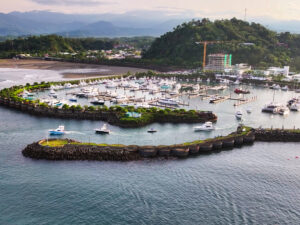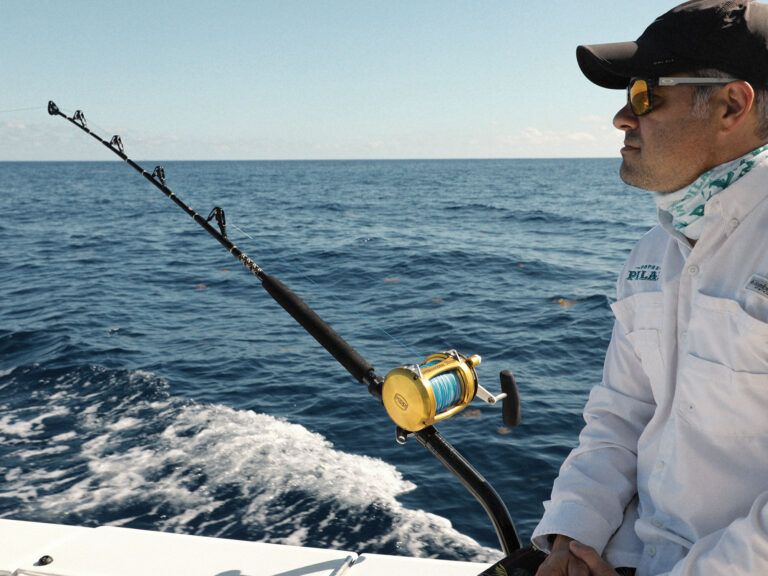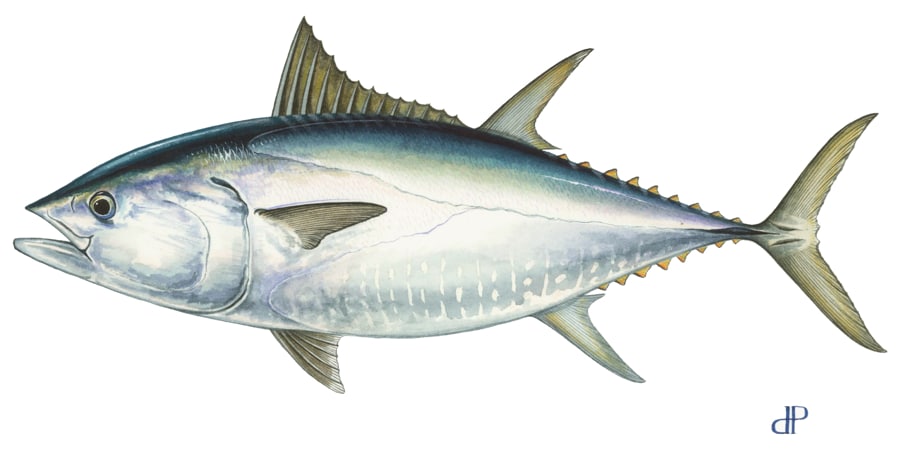
Bluefin are back.
Where Atlantic bluefin tuna had become scarce or absent, waters now teem with them. In regions where hardly a bluefin had been seen in decades, a bumper crop swarms in seasonal profusion.
In short, the Atlantic bluefin (AB) represent one of the greatest success stories of fisheries management in modern times.
Consider, the venerable IUCN red list (International Union for the Conservation of Nature) of threatened species; it listed AB as “endangered” in 2011. It has now changed that rating species of “least concern.”
Given this, it does seem rather ironic that fisheries management is quite literally what nearly killed the bluefin once and forever.
To understand that, a brief AB history lesson (for more specifics see the table “Management Milestones” at the end).
Dismal Decline and Remarkable Resilience
In 1966 a new management agency was conceived: ICCAT, the International Convention for the Conservation of Atlantic Tunas. In 1969 it began its work, made up of member nations on both sides of the Atlantic, to protect ABT — and maximize sustainable catch levels.
But the golden cow — an optimal bluefin tuna harvest — was far beyond the barn even before that barn (ICCAT) was built, and things got worse for tuna. In the 1960s and ‘70s, the species was besieged by overfishing from a number of sources in many areas, notably Japanese longliners ransacking the Gulf of Mexico, one of two known spawning grounds for AB giants, while purse seiners along the U.S. Mid-Atlantic coast scooped up juvenile tuna that would never have a chance to spawn.
Over concern for the species, in 1969 the National Marine Fisheries Service closed U.S. waters (in the Exclusive Economic Zone, out to 200 miles). But it was an effort too limited in scope and duration; in 1996, at least 50,000 metric tons of bluefin were being taken in the eastern Atlantic and Mediterranean — a harvest impossible to sustain. Nor did that take into account one of the gorillas in the room of bluefin management: What’s known as IUU — illegal, unreported and unregulated fishing, which added huge but indeterminate tonnage to that 50K total. Although authorities have found ways to reduce IUU, it remains a pervasive global threat to marine resources worldwide.
Despite international concern for AB, time and again in subsequent years, ICCAT disregarded recommended TAC (total allowable catch, or quotas) for the species, setting quotas much greater — as much as three times the levels recommended by ICCAT’s own scientists, bowing to pressure from big commercial-fishing interests. Among environmental NGOs and many in the recreational fishing community, the agency’s acronym became a bittersweet joke: the International Conspiracy to Catch All the Tunas.
By 2006, warning signs (notably stock assessments) showed clearly that bluefin tuna stocks were on the verge of collapse. Perhaps amazingly, ICCAT finally got serious and over the next few years began a strategic recovery plan with significantly reduced quotas, particularly in the eastern Atlantic, which generated most of the world’s Atlantic bluefin harvest, as well as limited seasons, a greater minimum size (10 to 30 kilograms), and banned the use of spotter planes.
Finally, with good management, AB proved their remarkable resilience. Stocks began to recover, particularly in the west, and by 2017 an ICCAT stock assessment showed the eastern stock no longer being overfished. Bluefin have returned to large regions from which they had essentially disappeared for decades. Huge tuna have been leaping into salmon net pens near the Norwegian coast and photographed jumping right in front of a Danish castle. And so on. Locals report seeing bluefin “by the thousands.” Similar abundance, albeit often of smaller bluefin, is reported for the Mediterranean and U.S. Northeast and Mid-Atlantic coasts.
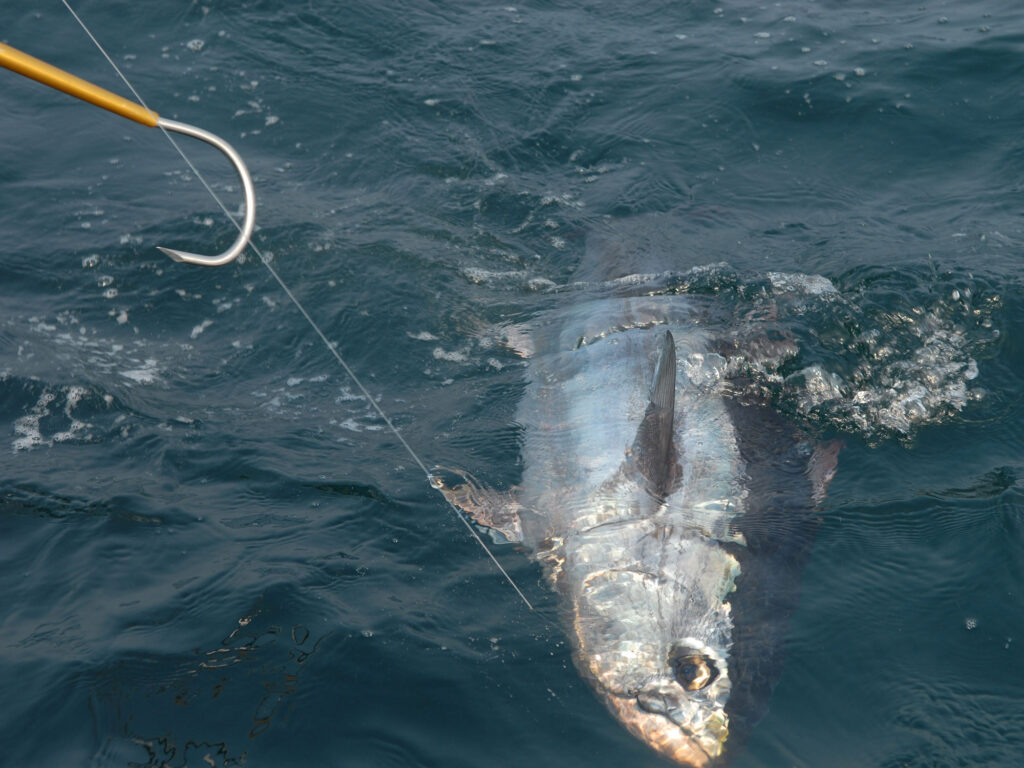
Class Management and the Northeast School Fishery
To understand Atlantic bluefin management and laws is to understand the language of size designations. Probably no other game fish is considered by so many precise size classes as are AB.
Below, “Atlantic Bluefin Tuna Size Designations” illustrates this. So many size designations reinforces both the intricacies of managing the species and the fact of their unparalleled economic and social value.
Atlantic Bluefin Tuna Size Designations (based on curved fork length; weights approximate)
- Young School — up to 27 inches (18 pounds)
- School — 27 to 47 inches (60 pounds)
- Large School — 47 to 59 inches (130 pounds)
- Small Medium — 59 to 73 inches (235 pounds)
- Large Medium — 73 to 81 inches (320 pounds)
- Giant — 81 inches or more (320 to 1,000 or more pounds)
Those designated as school bluefin (27 to 47 inches, and weighing roughly 20 to 60 pounds) are particularly important in the Northeast where they support a significant and outstanding recreational fishery, says Ray Bogan.
“Some 30 to 40 years ago, schools of school-size bluefin were uncommon in New England waters,” according to Bogan, a past ICCAT commissioner and probably more involved for more years with Atlantic bluefin on all levels than anyone. He’s also an enthusiast, when it comes to catching them. “The booming school-bluefin fishery now is really significant,” he says. “And it’s a fishery for the ‘common angler,’ if you will. He explains that the near-coastal bluefin don’t require bigger boats and longer runs needed for yellowfin and bigeye.
“The bluefin fishery in the New York bight has really resurrected itself in the past 10 to 12 years,” Bogan says. Fisheries in these waters still target primarily large, large-medium and giant fish. But for anglers, school fish provide fantastic action, often on poppers, stickbaits and jigs. Fish of that size were the main target for anglers from the 1930s through the late 1960s, when bluefin stocks collapsed and the fishery atrophied.
Proponents of the school fishery had to fight to have that sanctioned in ICCAT regulations. Bogan says at one point, the idea was floated for ICCAT to eliminate a legal school fishery (of minor importance to commercial interests) to help reduce total yield and allow stocks to recover. But Bogan and others pointed out the great important of school bluefin for the area’s recreational fisheries. As a result, ICCAT set the fishery for school fish at eight percent (of the total allowable bluefin catch) and has since upped that to 10 percent. (Still, Bogan points out, at one time, the allowance for school bluefin in the total catch was 12 to 15 percent.)
“School bluefin have not been around off New England, at least in my memory, in the numbers here now,” Bogan says, theorizing that climate change is a likely factor, as summer water temperatures are warm enough to attract small bluefin.
To understand the critical relationship of AB to water temperature, it’s essential to know that bluefin are that rarity among fishes: They’re endothermic. Not to be confused with homeothermic (which is truly warm-blooded; the opah is the only fish on the planet to claim that ability), endothermic fish are “warm-bodied.” So they can keep their bodies up to 20 degrees C above surrounding cold water as they hunt for food. The larger the tuna, the more effectively it can do this simply because its great body mass is less drastically affected by cold water. Thus, school bluefin remain farther south than some giants, which summer in the cold waters of the Canadian Maritimes and northern Europe to feed on the abundant forage fish that school there.
Another factor in the growing numbers of small bluefin starting around 2006 was that phenomenal year-class of 2003. Unusually warm waters where the tuna spawned led to far better than usual survival rates, and offered New England skippers like Dom Petrarca (coastalcharterssportfishing.com) great action on spinning tackle. “Cape Cod became an easy place to test gear when the 2003 year-class decided that southern New England was a good place to return each June,” he wrote for On the Water, July 31, 2023. Noting the annual growth of that class of ’03, Petrarca writes, “From 2006 to 2009, the average size of bluefin grew from the low 40-inch range to more than 60 inches,” necessitating continually larger, upgraded gear.
Those bluefin are by now large enough that “It’s getting tough for those who like to fish spinning gear,” according to another Northeast veteran captain, New York-based John McMurray (nyctuna.com), citing regular hookups with 70-plus inchers.
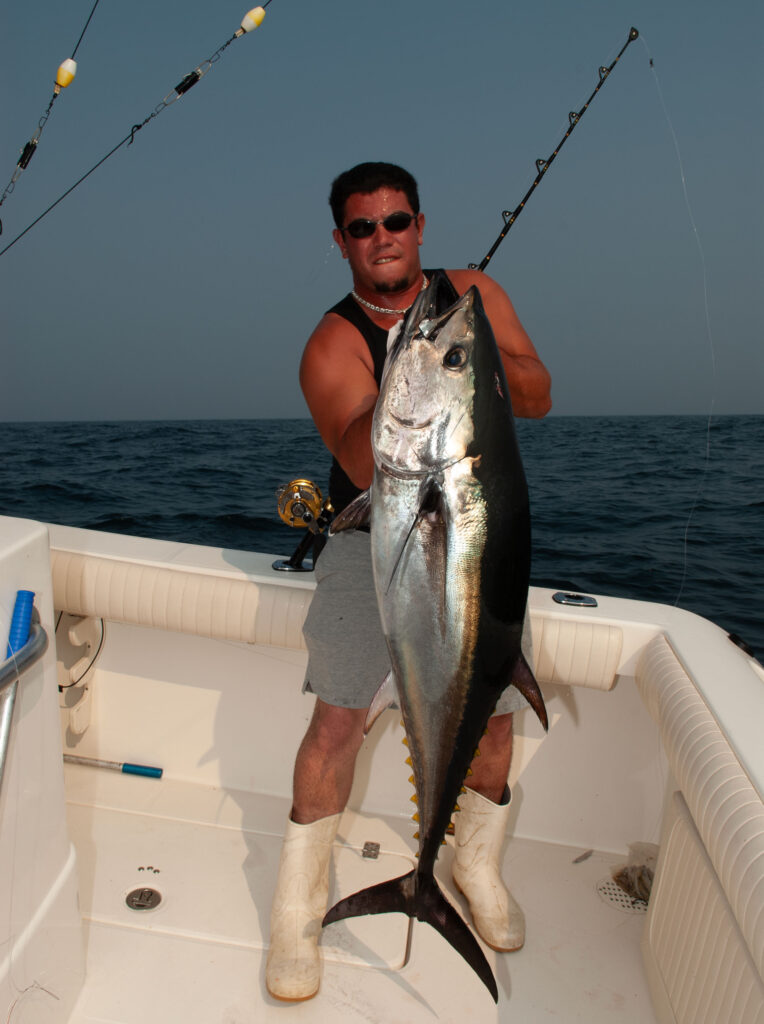
Big Fish in the Maritimes and Mid-Atlantic
Giants are the status target for anglers fishing out of Nova Scotia and Prince Edward Island, in Canada waters. The fishery has become legendary for the ginormous beasts that haunt nearshore waters here each summer and fall. Contributing to that legend, to be sure: the 1,496-pound all-tackle world record that Ken Fraser landed in Aulds Cove, Nova Scotia, in 1979.
Many granders-plus are caught annually, though weighing any to claim a record may be tough, since the fishery is by law entirely tag-and-release. While school fish are important farther south, small bluefin don’t generally figure in the fishery this far north. The first year of the government-sanctioned recreational fishery was 2009. Only registered commercial-tuna license holders may operate bluefin charters (and only in the same areas as their commercial license allows) during the July 15 to December 31 season, and are required to use heavy tackle and adhere to specific fight-time provisions. All fish are tagged as part of an ICCAT tagging program. That said, 10 tons – that’s 10 out of 530 tons (in 2020) — are allocated for mortality associated with charter fishing and also for a couple of annual tournaments.
Considering the size of the tuna here, an angler’s likelihood of hooking up (and not far from port) are remarkably high. After all, it’s fairly commonplace for anglers to return to the dock with stories — and photos — of leaning over the gunwale to hand-feed baitfish to tuna large enough to dwarf them. That’s bluefin in the Maritimes.
Ironically, bluefin here weren’t always prized. Quite the opposite in fact. In the 1960s, giant bluefin were known locally as “horse mackerel” and considered to be a nuisance that tore up nets and had no market value. Stories of monstrous bluefin left to rot or hauled off for fertilizer are hard to imagine, these days. Off the U.S. Mid-Atlantic coast, school and large-school AB may be taken throughout the year, many sport fishermen tend to focus on the big fish that move down the coast, following cooler water, from December into March. That wasn’t always the case.
Capt. Rom Whitaker (hatterasrelease.com) runs a 53 Bobby Sullivan out of North Carolina’s Hatteras Inlet and has an impressive perspective, having run charters here for 37 years. Whitaker, one of the pioneers of the Mid-Atlantic winter bluefin fishery recalls that magical time in the 1990s when the giant fish were discovered “hanging around the wrecks” during the cold months just offshore of Hatteras. “It was full-blown all-you-wanted-to-catch for about five years, December through March,” he says. “There might be as many as a hundred boats out there chasing tuna.” Whitaker is convinced schools of big (8- to 20-pound) bluefish were the reason the hefty bluefin hung around.
But they were happy to eat whatever they came across, including the pogies put out by anglers in what was mostly a chunk fishery. “Those fish were conditioned, so as soon as boats started putting out flats of menhaden, bluefin were in your wake, airing out on the baits. They were so aggressive, we started messing around with bananas and hot dogs; whatever you threw out there, they’d bite it!”
Around 2002, Whitaker says, the winter run started to taper off, but in 2008, big fish — 400 to 600 pounds — started showing up off Morehead City and Wilmington in water as shallow as 50 to 100 feet, chasing schools of menhaden. Quota restrictions limited fishing days each month, but by February and March, the fish were congregating off Oregon Inlet. That became the hot spot, Whitaker says, and spawned the Wicked Tuna phenomenon.
But since 2020, cold water seems to once again be making a harder push in the winter down the beach and around wrecks. “The big bluefish still aren’t showing,” Whitaker says, “but the bluefin are — big schools in the traditional areas,” in 25 to 60 fathoms. While plenty of tuna under 73 inches are caught, some 600 to 700 pounds have been mixed in.
“It’s not quite as good as it was in the 1990s,” Whitaker says, “but it’s improving. What I see is a healthy, growing stock of bluefin.”
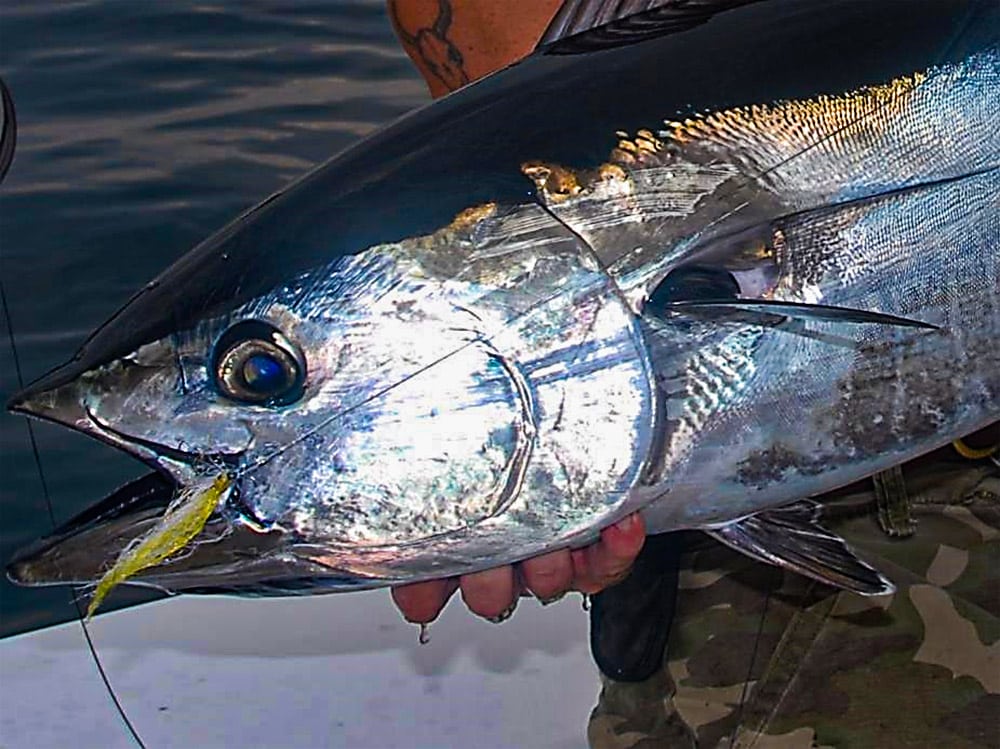
Northern Europe: Bluefin’s Remarkable Reappearance
Perhaps no point in the bluefin’s resurgence is more dramatic than what has happened starting in the past 10 years in the North Atlantic off the United Kingdom. Bluefin hadn’t been seen in these waters for more than 60 years, so when giant tuna began leaping and feeding just off the coast in 2014, eyes popped and jaws dropped. ICCAT had prohibited even incidental harvest for northern European countries. But by 2023, the first commercial bluefin fishing in more than 60 years was officially underway. So was a limited catch-and-release fishery. The bluefin were back.
No one was more excited or has been more influential in developing that legal recreational fishery than Englishman Steve Murphy of Surrey. After several years fishing for AB off England, Murphy says emphatically, “I’ve fished for Atlantic bluefin tuna in many locations, including Cape Cod, and it isn’t hyperbole when I say we have a phenomenal tuna fishery here in our western [UK] waters.”
But back in 2014, there was no way to legally fish for bluefin in the region. “The EU has never had a real grasp of the extent of a bluefin recreational fishery, even during years of their abundance,” says Ray Bogan.
In 2017, when there could be no doubting the strength of the army of bluefin massing off the coast, Murphy sought backing for a fishery from the Angling Trust, recognized by the UK government as the “official representative body” for anglers. He went on in 2019 to lobby for, gain approval of and design a scientific research program based on the Republic of Ireland’s CHART program (CatcH and Release Tagging) and started the UK Bluefin Tuna Association in 2022.
As a result of the efforts of Murphy and others, an official recreational catch-and-release fishery was recognized — and to cover any release mortality, was allowed a crumb (16 tons) of the country’s modest bluefin quota (post Brexit, the UK has had very little quota in total).
Murphy anticipates that this quota, in August, 2024, can support up to 100 licensed vessels (charter and private) to fish bluefin for a 4- to 4½- month season. Looking beyond, Murphy hopes that the UK will get still more quota share and would like to see an option for anglers to retain some trophy fish, as in the U.S. “Our problem is that retaining fish that average more than 200 pounds and reach 800 to 900 pounds would soon eat into any limited quota.”
To the south, the Mediterranean Sea has, as Bogan acknowledges, long “shown to be the most prolific region of all for bluefin, far and away.” It’s the primary spawning and nursery ground for all eastern Atlantic bluefin. And it’s also remarkably good fishing, arguably the best in the world for big-spin enthusiasts throwing lures and jigs, since “There’s a greatly expanded school-bluefin fishery in the Med, now,” Bogan says.
One pro who’s consistently taken advantage of abundant school-sized fish is Capt. Rob Nieuweboer (sportfishingspain.com) who fishes the waters near the coast in Spain’s Ebro Delta south of Barcelona. He describes the bluefin presence as very reliable for many years. The coveted “surface frenzies” occur in April and May, when 75- to 120-pounders churn the surface, feasting on baitfish. There’s no better time to throw a lure. In the fall, Nieuweboer chums up bluefin in the 150- to 400-pound range. He chooses to release all bluefin, though he says anglers can keep bluefin of at least 30 kilograms (66 pounds) and 115 centimeters. But once the quota has been filled, targeting bluefin, even for catch-and-release, is illegal. The Spanish commercial fleet took 7,000 tons in 2023.
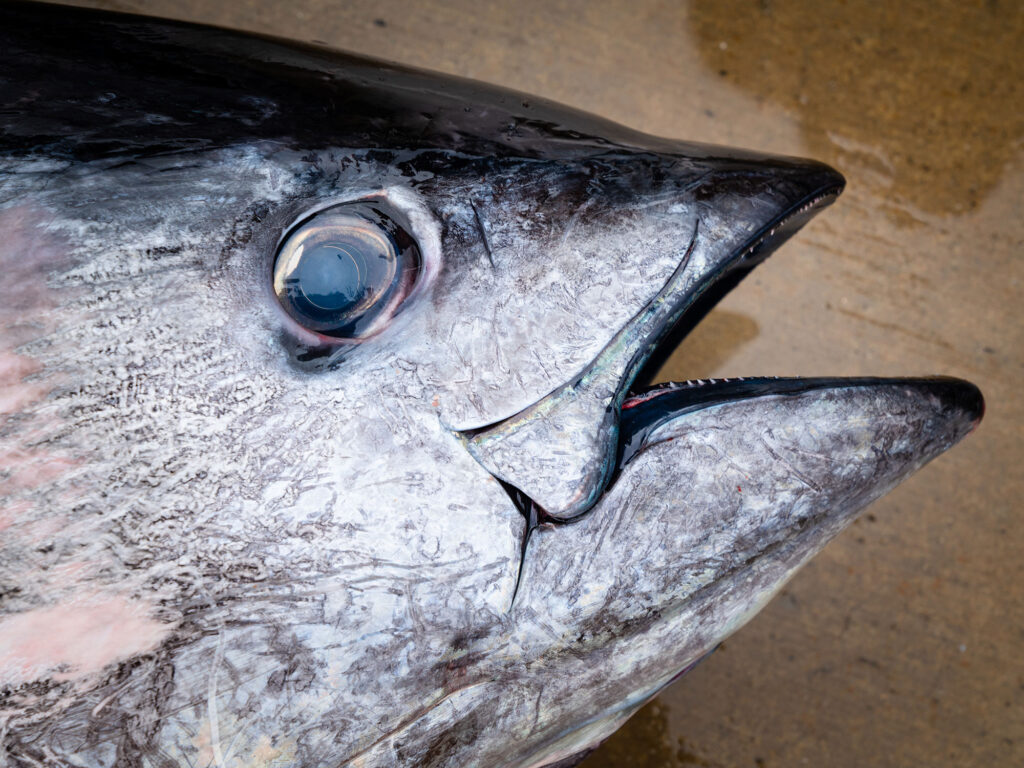
Still Learning
For decades, ICCAT managed AB based on the existence of two discrete stocks: the western Atlantic stock (which spawns in the Gulf of Mexico) and the eastern Atlantic stock (which spawns in the Mediterranean), and on the assumption that the two stocks mostly stayed on their own side of the Big Pond. Even when science began to show this isn’t the case, ICCAT was reluctant to manage accordingly. Why? Because they’d already shaped their protocols on the two-stock paradigm and managing that way was convenient.
In her 2023 book, Kings of Their Own Ocean: Tuna, Obsession, and the Future of Our Seas, Karen Pinchin writes that whereas the U.S. and Canada restricted catches to prevent overfishing, European harvests “remained a free-for-all with no quotas on how many fish could be caught and killed.” The end of that “free-for-all” earlier this century accounts largely for the reappearance of bluefin in northern European waters.
To further cast doubt on a two-stock model, and to better manage bluefin in the future, scientists have recently refined their understanding of bluefin spawning with a third major spawning area. The Slope Sea spawning area, as it has come to be known, refers to a region of the Atlantic off the U.S. Mid-Atlantic between the Gulf Stream and continental shelf. The area may prove to be a major spawning grounds for bluefin, and may increase in importance in coming years: Scientists have expressed great concern that the Mediterranean spawning/nursery grounds may become untenable for bluefin within 50 years, as climate change is projected to warm those waters above 28 degrees C, which is the cutoff for successful bluefin spawning. Thus, the tuna will have to seek out other suitable spawning grounds.
Whether Atlantic bluefin tuna can maintain their successful return for decades to come is mostly a function of human activity and decisions — such as how we handle renewed fishing efforts/quotas and control illegal fishing, and how we deal with (or fail to deal with) climate change. But for the moment, the bluefin are back, more dynamically than anyone could have guessed.
ABT Management Milestones
| 1966 – ICCAT formed (now 51 member nations) 1969 – ICCAT begins regulation of ABT 1969 – NMFS announces unprecedented one-year closure for Atlantic bluefin in U.S. waters ordered by ICCAT 1970s – Overfishing by longline vessels targeting spawning giants in GOM and by purse seiners off E Coast of America targeting juvenile bluefin 1990s – Overfishing peaks 1996 – 50,000 to 60,000 metric tons bluefin caught in Eastern Atlantic and Mediterranean 1998 – ICCAT establishes first TAC for bluefin – set at 30K tons/year 1998-2008 – Overfishing continues at estimated rate of 50K tons/year Early 2000s – IUU bluefin in the Med, far exceeds already too-generous quotas 2003 – Warmer-than-usual waters leads to high larval survival rate, major year-class success 2005-2007 – NGO’s increase pressure to end overfishing of bluefin 2006 – Stock assessment shows bluefin tuna stocks on verge of collapse | 2007 – ICCAT strategic 15-year recovery plan* is implemented 2007 – Weight limit set at 30 kilograms 2008 – Amended strategic plan, with restrictive bans and stricter IUU control and reduced TAC further 2009 – ICCAT now listens to scientists and reduces allowed catch still further 2010-2014 – bluefin stocks show improvement; eastern stock remains overfished 2011 – IUCN formally lists Atlantic bluefin tuna as “endangered” 2015 – As numbers improve, ICCAT allows a 20% increase in bluefin permitted catch 2015 – IUCN reclassifies bluefin to “near threatened” from 2011’s “endangered” 2016 – The first showing of bluefin in decades off northern Europe’s coast 2017 – ICCAT stock assessment shows eastern Atlantic bluefin no longer being overfished 2019 – With eastern stocks no longer overfished, ICCAT shifts from long-term-recovery management to multi-year management, and agrees to gradually increase permitted catch 2021 – IUCN changes rating of the species to “least concern” 2024 – Limited recreational tag-and-release fisheries announced for Norway, England and Ireland |
*plan reduced TAC and quotas, limited fishing seasons, raised min size for tuna from 10 to 30 kg, and more (incl outlawing use of spotter planes).

